Just thinking about cancer – the Big C – is a terrifying ordeal. There are very few of us who have not been touched by the disease in some way, whether personally or in a loved one.
But fear not, studies show that up to 70% of common cancers can be prevented through lifestyle choices.
Here are the 11 strict cancer prevention factors you are probably ignoring, listed from the most obvious to some you’ve probably never thought of.
Click next under the picture or Start Slideshow to continue reading.


1. Eat right and maintain a healthy weight.

Let’s start with the basics. To greatly reduce your risk of developing cancer, you’ve got to eat right and maintain a healthy weight. This means consuming lots of fruits, vegetables, and whole grains, and limiting fatty meats, especially those that are processed or charbroiled.
Refined sugars are linked to inflammation in the body, which can also up your risk of cancer. Avoiding processed or packaged foods can help reduce sugar intake.
2. Get your body moving.

A sedentary lifestyle carries a whole host of health risks, including cancer. Exercise is thought to boost your immune system, reduce inflammation, and speed up your metabolism.
All things that limit the effects of carcinogens on the body. Experts recommend a minimum of 2 ½ hours of moderate aerobic activity per week to reduce your risk.
3. Don’t use tobacco.

Although doctors once prescribed cigarettes to calm anxious mothers, we now know that smoking kills. It is strongly linked to lung, mouth, throat, larynx, pancreas, bladder, cervix, and kidney cancers.
Chewing tobacco is no better and has been linked to mouth and pancreas cancer. If you need help to quit smoking, the good news is that there are a lot of resources available to help. You might start with your doctor for recommendations.
4. Drink filtered tap water.

The President’s Cancer Panel suggests that public water is a safer bet then bottled, which is no better and sometimes worse than what you get from the tap.
Filtering at home will help reduce your exposure to carcinogens and hormone-disrupting chemicals that may be present. Also avoid drinking anything out of plastic bottles that contain BPA – stainless steel or glass containers are great alternatives.
5. Consume alcohol in moderation.

Studies have shown that drinking alcohol can increase your risk of esophageal, colorectal, head and neck, liver, and breast cancer.
Unfortunately, simply quitting alcohol won’t immediately lower your cancer risk. Your best option is to avoid drinking to excess. You can also choose to drink red wine – it contains resveratrol, which has been shown to have anti-cancer properties.
6. Protect your skin from the sun.

Sunburns are agony and increase your risk of skin cancer. To be skin smart, slather up with sunscreen and avoid the midday sun (between 10 a.m. and 4 p.m.).
Wear a hat and cover exposed skin – one Spanish study even suggests that choosing clothing that is blue or red protects better than clothing that is white or yellow.
Keep reading for some of the non-obvious cancer prevention factors.
7. Rethink your vitamin regimen.

It’s super convenient to take one multi-vitamin a day, but your favorite one may actually give you too much of certain nutrients.
For example, B vitamin (folic acid) is essential for women who are or may become pregnant, but consuming too much of the synthetic form has been linked to a higher risk of colon, lung, and prostate cancer. It may be healthier to choose individual vitamins for your specific needs rather than take one multi-vitamin.
8. Get sufficiently immunized.

Certain viral infections can also increase your cancer risk, so get sufficiently immunized. Hepatitis B has been linked to liver cancer.
The Human papillomavirus, or HPV, is a sexually transmitted virus that is linked to cervical and other genital cancers, as well as squamous cell cancers of the head and neck. Your doctor can help you decide if further vaccinations could help you.
9. Be careful with cell phones.

Yep, it can be a struggle to put down that smart phone! But a number of review studies suggest a link between cell phone use and brain cancer due to large amounts of radio frequency energy pressed right up against the skull.
Minimize your risk by using the speakerphone, and when you do put the phone to your head, try to keep it short. It might also be wise to store your phone in a purse or briefcase when not in use, rather than in a pocket pressed against your body.
10. Skip the drycleaner.

The primary solvent used in dry cleaning is called perchloroethylene, or perc for short. Workers who are regularly exposed to perc have been shown by the EPA and the National Academies of Science to have a higher risk of liver and kidney cancers as well as leukemia.
So it stands to reason that having perc pressed against your skin is not the healthiest choice. Many clothes can be hand-washed and air dried, or spot cleaned with white vinegar, for a much less toxic alternative.
11. Don’t top off your gas tank.

The risk here is that pumping any more gas after the automatic shut off has been triggered can lead to spills. We know that it feels better psychologically to get to an even dollar amount on the sale, but it’s not worth it!
A spill foils the tank’s vapor recovery system, meaning that carcinogenic chemicals like benzene get into the air and then on your skin or into your lungs.
Conclusion

There’s no getting around it – cancer is scary. But you have so much more power over it than you might think. Incorporating the tips provided here can make a huge difference in your lifetime risk.
With a commitment to education and the willingness to change our habits, one day we could wipe out this horrible disease entirely.
Besides these prevention factors, it’s incredibly important to be fully aware of certain cancer symptoms. Studies show, that spotting cancer early can significantly increase your chances of survival.
Click Next to learn the info that could save your life one day.
Cancer is a condition where your body’s cells grow uncontrollably and cause a tumor. The cancer can then spread to other areas.
You can get cancer anywhere, but there are a few body parts that are susceptible. The skin, your largest organ, is one of those places.
Be on the lookout for any of these risk factors: fair skin, history of sunburns or excessive sun exposure, living in sunny or high-altitude climates, lots of moles, precancerous lesions, family or personal history of skin cancer, weakened immune system, exposure to radiation or substances like arsenic.
There are three different types of skin cancer – basal cell, squamous cell, and melanoma. Each type looks a bit different from the others.
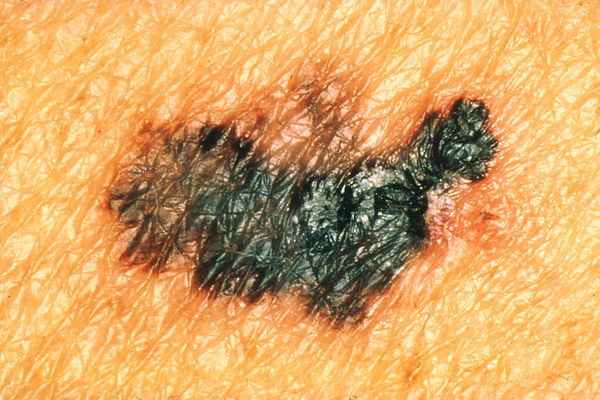
10. Rough, Scaly Patches
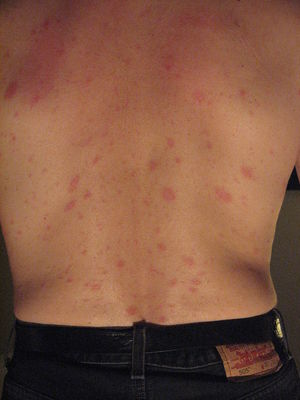
Keep a look out (and feel for) for rough, scaly patches that may range from brown to dark pink. You will often find them on a fair skinned person with a history of sun damage.
These will often appear on the face, head and hands. These rough patches are called actinic keratoses and are precancerous skin lesions.
If you aren’t certain, ask a doctor and then keep an eye on the area for any changes.
9. Pearly or Waxy Bump
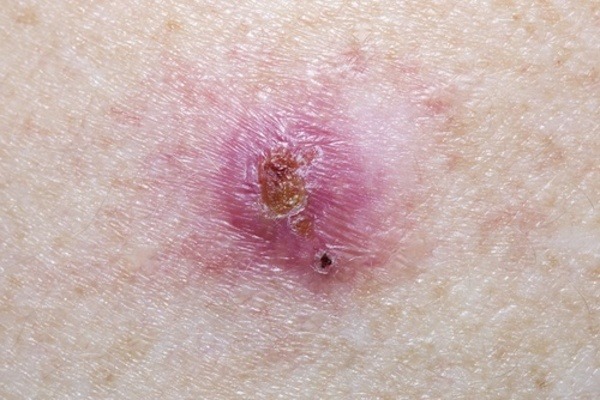
A pimple the doesn’t come to a head or changes sizes, keep an eye on it. If you develop a waxy bump under the skin or a bump has a sunken center, have a professional take a look at it.
A waxy or pale bump can be a basal cell carcinoma.
You may also see irregular blood vessels growing near the surface of the skin or have a tendency to bleed easily.
8. Flat, Flesh-Colored or Brown Scar-Like Lesion
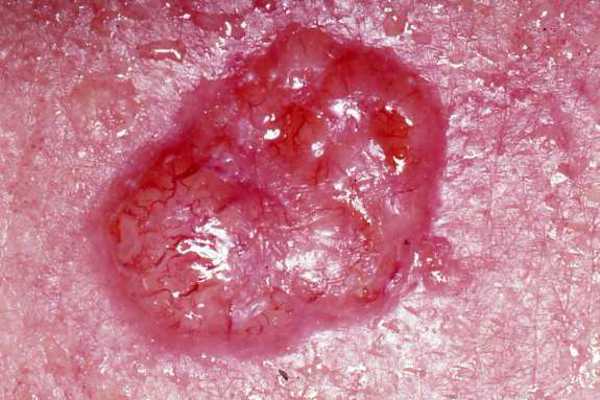
If you have a sore that won’t heal, has a sunken center or bleeds easily, have a doctor take a look at it. There are several reasons for scabs that won’t heal.
One of them is a basal cell carcinoma. This type of cancer is commonly found on the head, face, neck, hands and arms. It generally not aggressive and is easily treated.
Basal cell carcinomas can be disfiguring or leave behind scars, so treat early for best success.
7. Firm, Red Lesions

If you see a firm, dull red lesion that develops a sunken center or ulcerates, see a doctor. An ulcerated area might growth another ring of tissue inside the original area or develop as a crusty patch in a different color or refuse to heal.
It may look like a pimple or boil but won’t go away. These are most likely on the face, ears and hands.
Darker skinned people may develop lesions on areas not exposed to the sun.
6. Flat Lesion with a Scaly, Crusted Surface
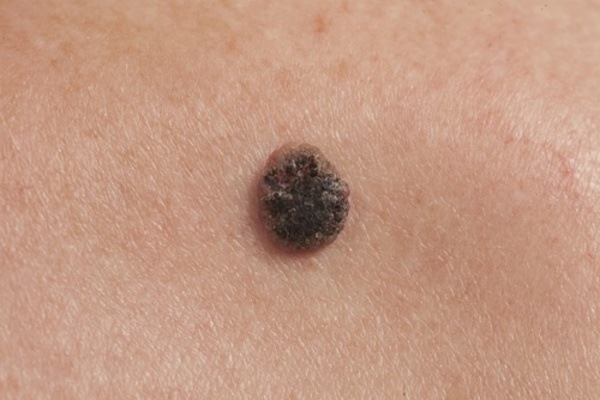
Flat lesions that develop a scaly surface or refuse to heal, like the previous lesions, may be squamous cell carcinomas.
These types of cancers can occur on the skin or even in the respiratory tract, GI tract, and hollow organs. They are not generally deadly but may become so. They can be disfiguring or cause scars, so treat early.
Squamous cell carcinoma is on the rise due to excessive use of tanning beds or excessive sun exposure.
5. Weird Moles
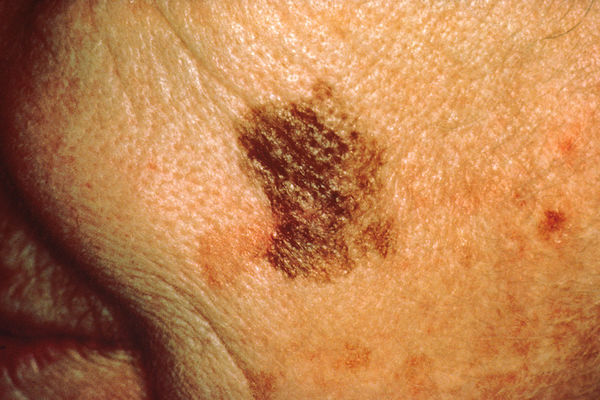
Keep an eye on moles. If one develops as a dark brown spot with darker speckles or an existing mole changes color, size, feel or bleeds, see a doctor immediately.
Changing moles may be a sign of melanoma. Melanoma is an aggressive and deadly cancer. Melanoma risk is a combination of genetics, UV caused mutations, and unknown factors.
Always check your moles for
- A (asymmetry)
- B (border irregularity)
- C (color multiplicity)
- D (diameter greater than ¼ inch)
- E (evolution or change in size and/or shape)
4. Lesion with Irregular Borders Colored Red, White, Blue or Blue-Black
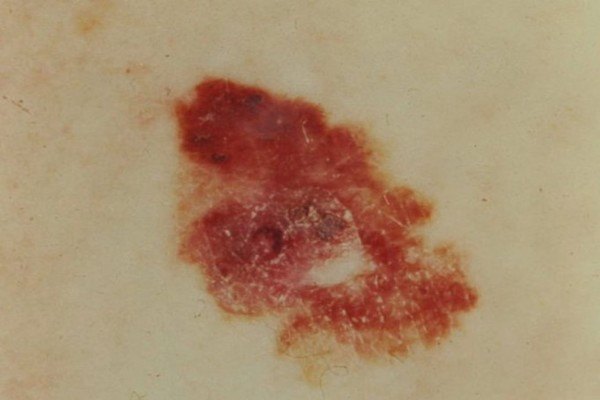
Melanoma may develop in odd places. Pay attention to palms, soles, fingertips or toes, or inside your mouth, nose, or around the vagina or anus.
Any odd-looking dark spot, especially if it appears suddenly, is an odd color, or hurts, should be checked out.
One person an hour dies of melanoma. If you aren’t certain, have the spot looked at. You may be overreacting, but you may not, and your life depends on early detection!
3. Hard, Yellowish Lumps on Eyelids
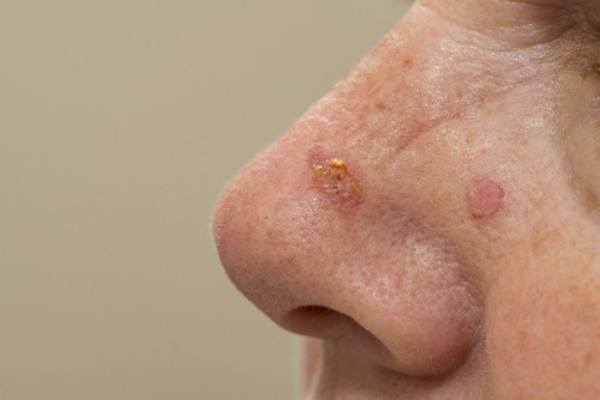
If you suddenly develop a hard yellow lump on your eyelid, have it checked out. These lumps may also appear on the head or neck, trunk, or genital area. These hard lumps can be a rare cancer, sebaceous gland carcinoma. They are slow growing and not particularly aggressive, however treating them is important!
These can be a clue that there is cancer elsewhere in the body (Muir Torré syndrome). They may also be benign (non-cancerous) and merely annoying.
2. Flesh-Colored or Bluish-Red Nodule
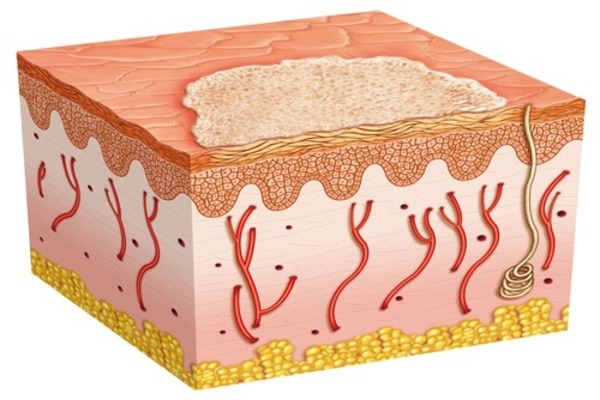
If you notice a red, blue or purple, or flesh colored bump that looks like a small boil or has a sunken center, see your doctor.
Merkel cell carcinoma is rare, but can be found on the face, head or neck. These are most commonly found in older people with a history of excessive sun exposure or a weakened immune system.
Merkel cell carcinoma is fast growing and will spread readily. Catching it early is helpful to the treatment.
1. Red or Purple Patches on the Skin
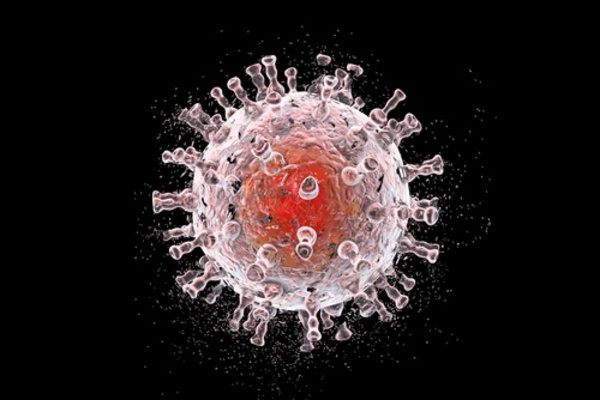
Red or purple raised patches can be a sign of Kaposi sarcoma. This skin cancer is very rare and generally occurs in people with AIDS or organ recipients.
It is sometimes found in young men living in Africa or older men of Italian or Eastern European Jewish ancestry.
Kaposi sarcoma develops in the skin’s blood vessels and creates painless lesions or tumors, most commonly on the face or legs. Tumors on the legs or groin may make the legs swell painfully.
Conclusion
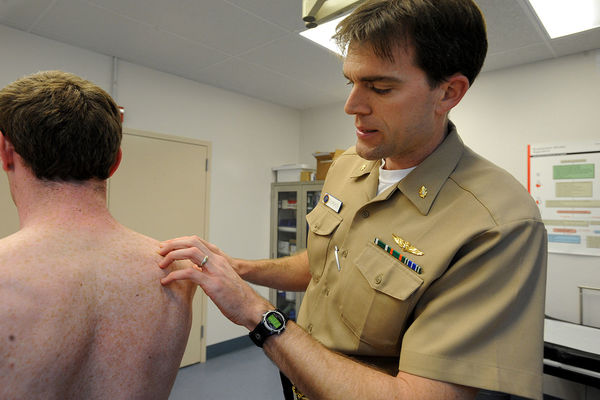
Cancer is scary and skin cancer is the most common cancer. Certain types can be very aggressive and deadly.
Check your body regularly to look for changing moles, scaly skin or odd-looking lumps. If caught early enough, most of these skin cancers can be treated successfully.
Stay out of the sun without proper protection, wear sunglasses, and avoid tanning booths. The fewer sunburns (and tans) that you have, the lower the risk of skin cancer.
Most skin cancers have their roots in sun damaged skin. However, there are other factors, so make sure you pay attention to your largest organ.



Comments